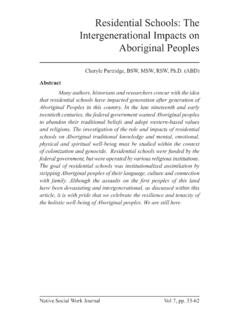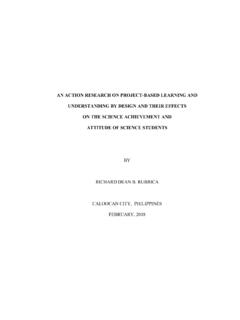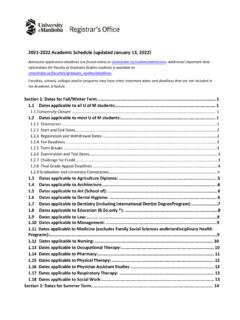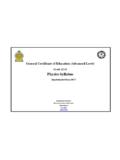Transcription of Reclaiming Michael: A Case Study of a Student with ...
1 Reclaiming Michael: A Case Study of a Student with Emotional Behavioural Disorder 2004. Carol R. Braun This thesis is submitted in partial fulfillment of the requirements for the Master in Education Degree, Faculty of Education at the University of Manitoba. Advisor: Dr. Zana Lutfiyya Committee: Dr. Jon Young Dr. Karen Smith Reclaiming Michael 2. ACKNOWLEDGEMENTS. I would like to acknowledge the following people for their participation and support in the completion of this thesis: Dr. Jon Young for his help in finding an advisor and participating on the committee, Dr. Karen Smith for her writing recommendations as a participant on the thesis review committee, Dr. Zana Lutfiyya for her invaluable advise in setting up the Study and analyzing the data, and for her participation on the thesis review committee. I would also like to acknowledge the willing participation of all thirteen people interviewed for the Study .
2 I would like to extend a special thanks to Michael and his mother Tina for allowing me to Study this part of their lives. Finally, I. would like to acknowledge the encouragement and support I received from Wheatland School Division to complete this work at a school in their division. Reclaiming Michael 3. ABSTRACT. Reclaiming Michael: A case Study of a Student with emotional behavioural disorder describes the work in a school with a kindergarten to grade three Student who was labeled emotionally-behaviourally disordered. Thirteen participant interviews were transcribed and analyzed to understand what the school did, how the school did this work, and why the work was done the way it was. Two themes reinforcing the importance of learning and building community emerged from the data. The data collected reinforced the general principles of both the ecological and humanistic perspectives, indicating theoretical possibilities for work with students with emotional-behavioural disorders in other schools.
3 Reclaiming Michael 4. CHAPTER ONE - THE NEGATIVE PROGNOSIS. I base it on the fact of 's this kind of kid. He comes from this kind of background. I've seen lots of kids like that, right? And I'm old enough now I've watched it for a long time.. So I've got this big case file in my head. And I know how they should progress. Roughly.. And I tend not to tell people that. Cause they get discouraged if you tell em that (Nelson transcript, 2004). Jeffrey Buffalo was a nine year old native boy featured in two one-hour radio documentaries on CBC radio's Sunday Morning on December 7, 2003 and then again on September 5, 2004. In his short time in the elementary school in Timmins, Ontario, Jeffrey was excluded from the school more than he was included. The documentary sympathized with Jeffrey and his frustrated grandparents and implied that the school system was inept, overtaxed by students with special needs, and unjust in keeping Jeffrey out of school.
4 Jeffrey was excluded from school by the area school board because of his behaviour and the board's zero tolerance policy (Wells, 2003; Wells, 2004). In the broadcast, the description of Jeffrey's behaviours and his diagnoses by eight different psychiatrists indicated that in Manitoba, Jeffrey would be labeled emotionally- behaviourally disordered. According to a body of literature on students with behaviour problems, few schools have successfully met the challenge of engaging students with emotional- Reclaiming Michael 5. behavioral disorders (EBD) in the academic and social programs of regular classrooms (Bierman, Cole, Dodge, Greenberg, Lochman, McMahon, & el al., 2002; Eber, 2002;. Lewis, Sugai, & Colvin, 1998; Scott, 2003; Stein & Merrell, 1992; Sutherland, 2000;. Sutherland, Wehby, & Yoder, 2002). However, in rare cases, schools have successfully nurtured positive behaviour changes in students labeled EBD.
5 One such case occurred at Ryerson School, the focus of this case Study . Michael is a pseudonym for an eight-year old Student in Ryerson School, a small, rural school in Manitoba. Michael was labeled emotionally-behaviourally disordered, Level Two. When he started kindergarten, he threw daily, out-of-control temper tantrums in the classroom, ran away from school, and tortured cats in the community. Three years later, in grade two, Michael was engaged in the academic and social programs of his classroom and the school. In grade three, despite huge daily challenges for Michael, his classmates, and the teacher, Michael stayed in school. He was not fixed and his behaviour still challenged the staff and resources of his school. Somehow the school met these challenges without excluding Michael from school. This case Study focuses on the question: what did Michael's school do to support his academic and emotional growth and keep him in school?
6 The change from out-of-control behaviour to normal classroom functioning in students with emotional-behavioural disorders is rarely seen. The question for this case Study research was What did Ryerson School do to work with their Student labeled EBD. Level Two? I conducted a case Study of the contextual conditions in which Michael's behaviour changes occurred to attempt to uncover the interaction of significant factors characteristic of [this] phenomenon (Merriam, 1998, p. 29). The data in this case Study was people's perspectives of what happened. Through interviews and examination of Reclaiming Michael 6. written records, I constructed a comprehensive, detailed picture of what people in Michael's school did and how they did it. From this practical representation, connections were made between an actual scenario, and the theories and research on effective school responses to students labeled EBD, or emotionally-behaviorally disordered.
7 I have provided a specific realistic description of one school's experience with one Student and compared it to the theories of what should work. Reasons to Conduct this Study There were many reasons to conduct this case Study of what one school did to work with a Student labeled EBD Level Two. The question of how schools can work effectively with students with EBD is important to me on a personal level, but as the Fixing Jeffrey Buffalo broadcasts indicate, it is also a provincial and national issue. As a teacher and a guidance counselor, it has been my experience that school personnel, and teachers in particular, are often overwhelmed and frightened by students whose emotional state and behavior is always unpredictable and often out-of-control. The literature supports this experience (Ellingson, Miltenberger, Stricker, Galensky, & Garlinghouse, 2000; Skiba & Peterson, 2000; Sutherland, 2001).
8 Jeffrey Buffalo's sad experience is all- too-often the case, as the much-used solution of exclusion starts early. These students are put out into hallways, serve in-school suspensions, sit in isolation, are sent home for various lengths of time, and are frequently suspended and expelled from schools. In the case of Jeffrey Buffalo, he was actually excluded from school since he could not be indefinitely expelled from a public institution, but he could be indefinitely excluded (Wells, 2003). The success of these strategies is short-lived and unsatisfying. The short- term respite for the school system damages relationships with these children and their Reclaiming Michael 7. families, and exacerbates the long-term academic and social problems for these students. School administrators, teachers, and educational assistants need to know specifically how to support behavior changes in students with EBD to keep them in classrooms, learning with their peers.
9 Since success with students with EBD is so rare, exceptions merit examination. This case Study highlighted the work of Ryerson School and attempted to distill the attitudes, approaches, skills in and out of the classroom, and methods that contributed to the changes and growth of Michael, their Student with EBD. The case researched the question What did Ryerson School do to work with their Student labeled Level Two EBD? . Along with my personal and professional observations, this case Study is important on a provincial level. Seven school divisions in Manitoba are currently participating in the third and final year of a provincial pilot project to implement effective practices for students with emotional and behavioral disorders. In this pilot, how school divisions access funding and supports for students with EBD changes. At this time, school divisions submit individual applications for funding to the province for approval.
10 In the pilot, a block of dollars is allocated to school divisions and they determine where funding is allocated. This change increases the need for a common understanding of the nature and impact of emotional-behavioral disorders, as well as the need for effective strategies to respond to these special needs. If school divisions are to allocate funding where it is most needed and best used then everyone - from teachers to resource teachers to clinical services personnel to administrators - needs to understand what programs and strategies best facilitate the inclusion and success of students labeled EBD. The funding to support students with EBD needs to be based on evidence of strategies that work. The Reclaiming Michael 8. case I examined began in 2001, before the funding changes and current government recommendations were proposed. The information gathered about what Ryerson School did to work with their Student labeled EBD Level Two provided an opportunity to compare this reality with the theoretical frameworks and provincial recommendations for successful work with students labeled EBD.











